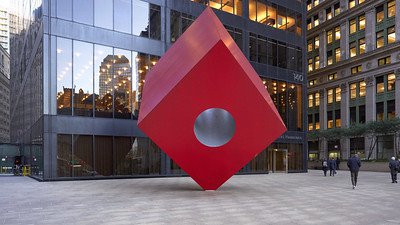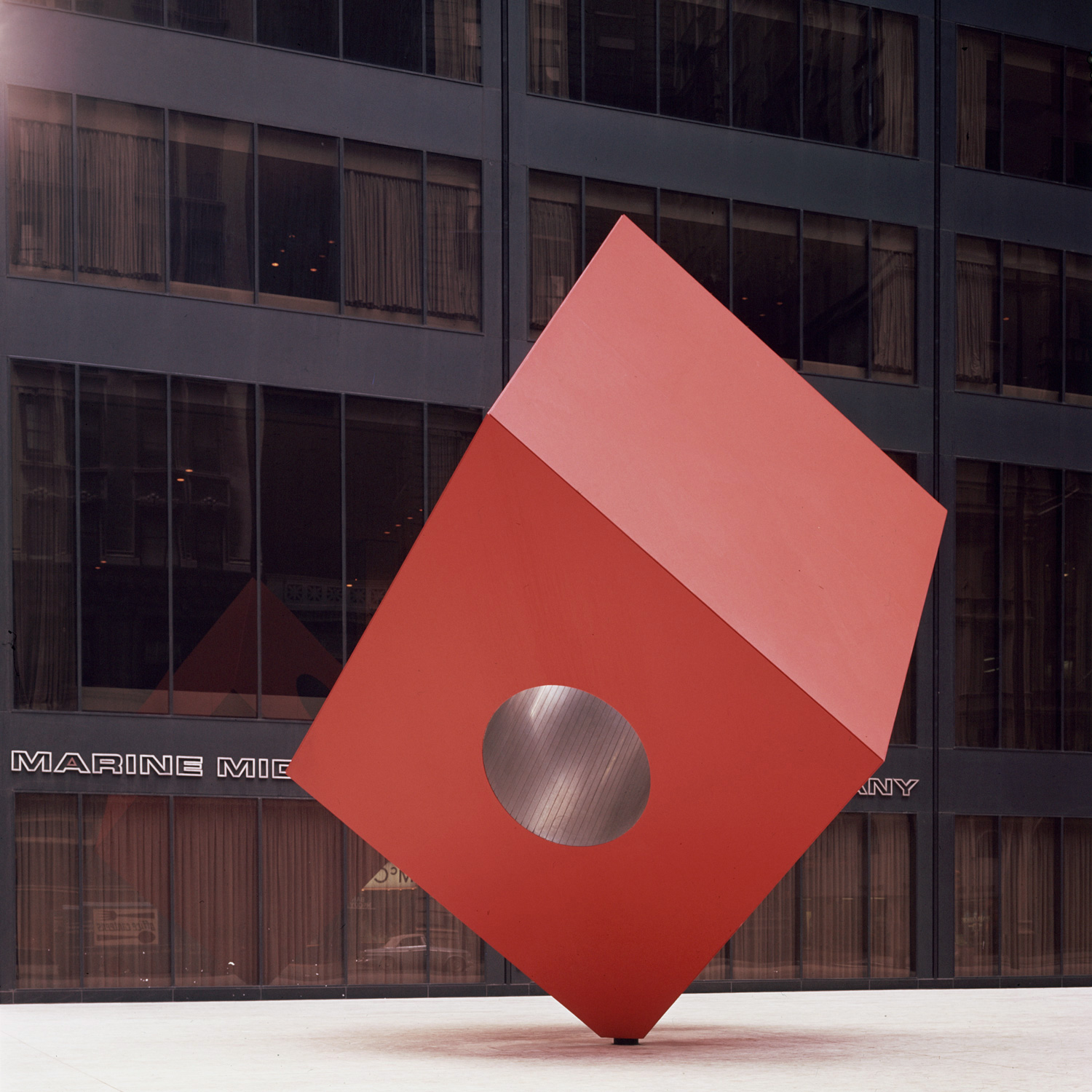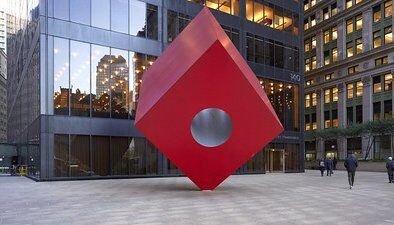The Red Cube in NYC is a striking piece of public art. Its bold color and geometric form catch the eye of every passerby.
But who is the artist behind this iconic sculpture? Created by Japanese-American artist Isamu Noguchi, the Red Cube stands as a symbol of modern art in New York City. Noguchi’s work is known for its harmony between nature and architecture, and the Red Cube is no exception.
This sculpture, with its vibrant red hue and dynamic tilt, reflects Noguchi’s unique vision. Nestled in the bustling Financial District, the Red Cube not only contrasts the surrounding skyscrapers but also complements the urban landscape. Discover the story behind this masterpiece and learn about the artist who brought it to life.

Credit: citydays.com
Introduction To The Red Cube
The Red Cube in NYC is a striking piece of public art. This sculpture has fascinated both locals and tourists. Its bright color and unique design stand out in the busy cityscape.
Historical Context
The Red Cube was created by artist Isamu Noguchi in 1968. Noguchi was a renowned Japanese-American artist. His work often blended eastern and western influences. He designed the Red Cube to bring a bold statement to the urban environment.
In the 1960s, public art was gaining popularity in NYC. The Red Cube became one of the most iconic pieces from that era. It represents the blend of art and architecture. Noguchi’s designs often explored balance and harmony, which the Red Cube embodies.
Location And Significance
The Red Cube is located at 140 Broadway in Manhattan. This area is a hub of financial and commercial activity. The sculpture sits outside the HSBC Bank building.
This location is significant for several reasons:
- It attracts attention in a busy part of the city.
- It offers a striking contrast to the surrounding tall buildings.
- It provides a unique spot for visitors to take photos and enjoy art.
The Red Cube’s placement at such a prominent location ensures it remains a well-loved landmark. It symbolizes the intersection of art and daily life in NYC.
The Visionary Artist
The Red Cube in New York City is a captivating piece of art. This sculpture is a testament to the brilliance of its creator. The visionary artist behind the Red Cube is Isamu Noguchi. His work continues to inspire and amaze. Let’s delve into the artist’s background and influences.
Artist’s Background
Isamu Noguchi was born in 1904 in Los Angeles, California. His father was Japanese, and his mother was American. This mix of cultures deeply influenced his work. Noguchi spent his early years in Japan. He returned to the United States for his education. He studied at Columbia University and the Leonardo da Vinci Art School.
Noguchi’s career began in the 1920s. He worked under the famous sculptor Gutzon Borglum. Borglum is known for creating the Mount Rushmore monument. Noguchi’s early experiences shaped his artistic vision. His unique background set him apart from his peers.
Artistic Influences
Noguchi’s work draws from a variety of influences. His Japanese heritage played a significant role. He incorporated traditional Japanese aesthetics into his art. These elements are evident in the Red Cube. The sculpture reflects simplicity and balance. Noguchi was also influenced by modernist movements. He admired artists like Constantin Brâncuși and Pablo Picasso.
His time spent in Paris in the 1920s exposed him to avant-garde art. He worked with prominent artists and absorbed their techniques. This blend of eastern and western influences defined his style. Noguchi’s art transcends cultural boundaries. It speaks a universal language of form and space.
In the 1930s, Noguchi traveled extensively. He visited China, Mexico, and India. These travels expanded his horizons. He embraced new ideas and techniques. The Red Cube is a result of this rich tapestry of influences. It stands as a symbol of Noguchi’s visionary genius.
Creation Of The Red Cube
The Red Cube in NYC is a fascinating piece of public art. Created by the renowned artist Isamu Noguchi, it stands as a symbol of creativity and innovation. Let’s dive into the creation of this iconic sculpture.
Concept Development
Isamu Noguchi wanted to create something unique. He envisioned a simple geometric shape. A cube, but not just any cube. He aimed for it to be bold and striking. The idea was to make it stand out in the busy cityscape.
Design Process
Noguchi meticulously planned the design. He chose bright red for its eye-catching quality. The cube was designed with a diagonal tilt. This gave it a dynamic and engaging look. He also included a hole in the center. It added depth and curiosity to the piece.
The materials used were carefully selected. Steel was chosen for its durability. The red paint was applied with precision. This ensured the sculpture would withstand time and weather. The final product was a perfect blend of art and engineering.

Credit: www.noguchi.org
Materials And Techniques
The Red Cube in New York City stands as a stunning piece of public art. Its creation involved careful selection of materials and innovative techniques. Both elements contribute to the sculpture’s iconic appearance and lasting impact.
Choice Of Materials
The artist chose steel for the Red Cube. Steel provides strength and durability. This material ensures the sculpture withstands harsh weather conditions. The red paint is vibrant and eye-catching. It contrasts beautifully with the urban landscape.
The choice of materials also reflects the artist’s vision. Steel and paint symbolize industrial strength and modernity. These elements blend well with the city’s architecture.
Unique Techniques
The artist used innovative techniques to create the Red Cube. One key technique was precise geometric design. This approach gives the sculpture its distinct shape. The cube appears to balance on one corner. This creates a sense of tension and movement.
Another technique involved careful welding of steel panels. This ensures seamless joints and a smooth surface. The artist also applied multiple coats of paint. This process enhances color depth and durability.
Installation Challenges
Installing the Red Cube sculpture in NYC came with unique challenges. This iconic artwork by Isamu Noguchi required careful planning and execution.
Logistical Hurdles
Transporting the Red Cube to its site was a major task. The sculpture is large and heavy. It required special vehicles and equipment. The streets of New York are busy. Navigating through them was a complex job.
Another issue was finding the right spot. The location needed to be visible and spacious. This was crucial for the sculpture’s impact. The team had to work with city officials. They needed to secure permits and ensure safety measures.
Technical Solutions
The installation required advanced techniques. Engineers had to ensure the sculpture’s stability. They used state-of-the-art tools and methods. They designed a strong base to support the weight. This was important for long-term durability.
The team also faced weather challenges. New York experiences various weather conditions. The materials used needed to withstand these changes. Special coatings were applied to protect the sculpture. This ensured it would remain in good condition.
Overall, the installation of the Red Cube was a complex process. It involved careful planning and expert execution.
Public Reaction
Artist of the Red Cube in NYC has been a subject of fascination and discussion for decades. The giant red cube, created by the Japanese-American artist Isamu Noguchi, stands as a vivid symbol of modern art. Its bold presence in the bustling cityscape of New York City draws attention and ignites curiosity among residents and tourists alike. Let’s dive into the public’s reaction to this iconic piece.
Initial Reception
When the Red Cube was unveiled in 1968, it stirred a mix of emotions. Some people were in awe of its striking design and its ability to stand out in the urban environment. Others were confused by its abstract form and questioned its place in the city. Critics and art lovers debated its meaning, and it became a hot topic in conversations about modern art.
In the early days, people often gathered around the cube, taking photos and discussing its significance. Some felt a strong connection to the artist’s vision, while others found it challenging to understand. The media covered the unveiling extensively, adding to the buzz and excitement surrounding the artwork.
Long-term Impact
Over the years, the Red Cube has become a beloved landmark in NYC. It has grown to symbolize the city’s embrace of diverse artistic expressions. Many people now see it as an integral part of the city’s cultural fabric. The cube’s bold color and geometric shape have made it a popular spot for photography, and it regularly appears in social media posts and travel blogs.
Art students and enthusiasts often visit the site to study Noguchi’s work and draw inspiration from it. The cube has also influenced the creation of other public art pieces in the city, encouraging a trend of incorporating modern art into public spaces. It serves as a reminder of the lasting power of art to provoke thought and inspire creativity.
The Red Cube has had a significant impact on how public art is perceived and appreciated. It has shown that even the most abstract forms can become cherished symbols over time. As a result, the public’s initial skepticism has transformed into a deep appreciation for this unique piece of art.
Cultural Significance
The Red Cube in NYC is not just a sculpture. It has deep cultural importance. This piece of art by Isamu Noguchi captures the essence of modern art. It also reflects the unique spirit of New York City. The Red Cube stands tall in the bustling financial district, inviting people to pause and reflect.
Symbolism Of The Cube
The Red Cube symbolizes balance in a chaotic world. Its tilted position suggests instability. Yet, it stands firm, showing strength and resilience. The bright red color attracts attention. It stands out against the grey buildings, reminding us of the power of art to transform spaces. The hollow center invites viewers to look through it, offering a new perspective on the city.
Impact On Nyc’s Art Scene
The Red Cube has had a significant impact on NYC’s art scene. It was installed in 1968, during a time of great social change. The sculpture brought modern art to the public. It made art accessible to everyone, not just those who visit museums. The Red Cube inspired other artists to create public art. It contributed to the growth of NYC as a global art hub.
Over the years, the Red Cube has become a beloved landmark. It is a popular spot for photos and gatherings. It also serves as a reminder of the importance of art in urban spaces. The sculpture continues to inspire new generations of artists and art lovers. It shows that art can thrive in the heart of a busy city.
Legacy Of The Artist
Isamu Noguchi, the artist behind the iconic Red Cube in NYC, has left an indelible mark on modern art. His work continues to inspire and influence artists, designers, and architects worldwide. Through his unique vision, Noguchi has created a lasting legacy that remains relevant in today’s art world.
Continued Influence
Noguchi’s art transcends time. His innovative use of geometry and space challenges conventional design. Artists today draw inspiration from his work. They incorporate his minimalist style and explore similar themes in their creations.
His sculptures are more than just art pieces. They are experiences. The Red Cube is a perfect example. Positioned at 140 Broadway, it invites viewers to interact with it. This interaction is what makes Noguchi’s work so influential.
Recognition And Awards
Throughout his career, Isamu Noguchi received numerous accolades. Here are some notable awards:
- National Medal of Arts (1987)
- Order of the Sacred Treasure from Japan (1989)
- Guggenheim Fellowship (1927)
These awards highlight his contribution to the world of art. They also serve as a testament to his enduring influence.
He was also recognized by leading institutions. The Guggenheim Museum held retrospectives of his work. The Isamu Noguchi Foundation and Garden Museum in Queens, NYC, is dedicated to preserving his legacy.
Noguchi’s impact on art is undeniable. His work continues to be celebrated and studied. His legacy lives on through his sculptures, awards, and the institutions that honor his contributions.

Credit: citydays.com
Frequently Asked Questions
Who Created The Red Cube In Nyc?
The Red Cube in NYC was created by artist Isamu Noguchi. It was installed in 1968 and is a famous abstract sculpture.
What Is The Red Cube Made Of?
The Red Cube is made of steel painted in bright red. Its geometric shape and vibrant color make it a distinctive landmark.
Where Is The Red Cube Located In Nyc?
The Red Cube is located at 140 Broadway in Lower Manhattan. It stands in front of the office building at this address.
Why Is The Red Cube Famous?
The Red Cube is famous for its bold, modern design and striking color. It is a popular spot for photography and public art enthusiasts.
Conclusion
The artist of the Red Cube in NYC has left a lasting legacy. This striking sculpture continues to captivate visitors daily. Its bold design and vibrant color stand out in the urban landscape. The Red Cube invites curiosity and admiration from all who see it.
Its presence enriches the city’s artistic heritage. Next time you’re in NYC, take a moment to appreciate this iconic piece. It’s a testament to creativity and vision. The Red Cube remains a symbol of art’s power to inspire.
